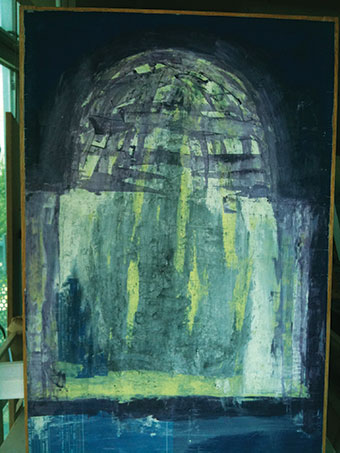Next story: Ani Hoover and Felice Koenig at Indigo Art Gallery
Tim Raymond, Dana Hatchett, and Kate S. Parzych at Artspace
by Jack Foran



In Suspect Terrain
Excellent artworks by painters Tim Raymond and Dana Hatchett and photographer Kate S. Parzych are currently on exhibit at Artspace. The title of the exhibit is the title of a book by John McPhee on shifting plate tectonics, In Suspect Terrain.
Raymond’s paintings range from surface texture interest abstractions to painterly representational and semi-representational works. Such as one that presents what seem to be numerous segments of rocky landscape or seascape layered up and down the vertical length and cheek-by-jowl across the width of the painting. The landscape or seascape idea is primarily indicated by frequent intrusions of blue horizontals—so sea or sky, it would seem—amid the copious possible rocks.
Raymond’s paintings, or most of them, are in acrylics on found paper on board, usually 8-1/2-by-11-inch sheets, the faint interstices between which quietly reassert the fundamental vertical and horizontal dimensions of the picture plane, and sometimes add ghostly pictorial elements. In one stunning work, depicting just the black hull of a sailing ship—no masts, no sails—adrift in a blue sea that seems to be more about pictorial void space than aqueous physical matter, the interstices lines are oblique as well as vertical and horizontal, evoking the oblique forms of the missing sails and (unseen in any case) keel.
Another piece depicts an architectural form, a painterly schematic of a simple box understructure with a dome, the found paper in this case being an engineering blueprint. It turns out to be the building the iron skeleton of which remained standing amid the acres of rubble after the atomic bombing of Hiroshima, and was left standing, grimly skeletal, as a memorial of the devastation. I thought at first, before recognizing the Hiroshima reference—war being war, enmity being enmity, destruction being destruction—the piece was in reference to 9/11. Or possibly, with a nod to the upcoming historical preservation conference, a recollection of the beautiful little dome structure bank building at the foot of Main Street—it looks a little like that building looked—that Jimmy Griffin determined to demolish, setting off a squabble with the preservationists, putting a crimp in the mayor’s plan, until he had a worker on the taller building next door “accidentally” drop a few concrete blocks or the like from several stories up, onto and right through the dome, pretty much mooting the argument with the preservationists. Proceed with demolition. The piece evokes all of these things. Hiroshima, 9/11, destruction/preservation. Remembrance, folly.
Painter Dana Hatchett has a grid display of 45 smallish works on paper in often dark and somber tones and a continuum variety of techniques—from graphite and color pencil drawings to watercolors to wash over drawings to acrylics—that accord with the variety of representational styles—from straight representational to abstract—in reflecting a continuum of imaginative transformation of the source actual object to artistic result. Which is also to say, the continuum from real to imaginary. Boulders look like boulders in the pencil drawings. In the paintings, the precise subject matter can be obscure beyond easy recognition. Subject matters are in general of two types, nature scenes and what seem to be architectural depictions. In both cases, the work is more about the transformation process—in the mind, in the memory, and in the artistic rendering, the working and reworking—than straight representation. The dark colors and murky atmospherics often lend a distinctly gothic touch.
The grid arrangement of the 45 individual works then fosters comparisons among them as to style and subject matter and technique, and the recognition of how—as the artist avers in his written statement—the whole is greater than the sum of the parts. The parts meanwhile are beautiful on their own, and stand on their own.
Kate S. Parzych’s photos are for the most part of water surfaces that reflect skies above and refract and distort stones and seaweed below, capturing uncannily lovely patterns of variegated color and light.
She also has a grid arrangement (similar to Hatchett’s grid arrangement) of nine similar-imagery photos of water reflecting or refracting a chain-link fence further grid pattern, which more particularly subject matter grid is partially disintegrated, deconstructed, by the aqueous environment, which also includes—as if by way of intrusion into the more formal grid patterning—delicate bits and portions of desiccated local flora. Very complex, very interesting.
Also to be noted, Tim Raymond has a current display in the lobby of the Irish Classical Theater of pen and ink and watercolor wash sketches on the fly of actors and actresses in action from the previous five ICT productions. All your favorites—or many of them—from Patrick Moltane and Cassie Gorniewicz as Chris Mahon and Pegeen in Playboy of the Western World, to Morgan Chard as Lucrezia in The Mandrake (“What have I done?”), to Vincent O’Neill as John in Shining City (“It was fookin’ madness, y’know?”). Great fun.
The sketches at the ICTC will be up through at least September. The three-artist show at Artspace runs through September 25.
blog comments powered by Disqus|
Issue Navigation> Issue Index > v10n37 (Week of Thursday, September 15) > Art Scene > Tim Raymond, Dana Hatchett, and Kate S. Parzych at Artspace This Week's Issue • Artvoice Daily • Artvoice TV • Events Calendar • Classifieds |









 Current Issue
Current Issue